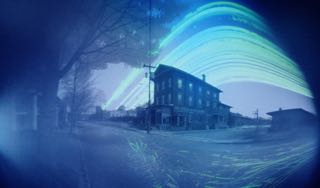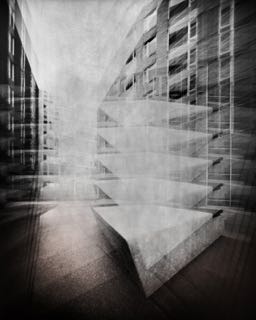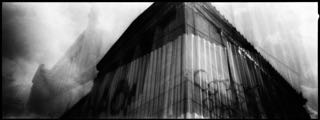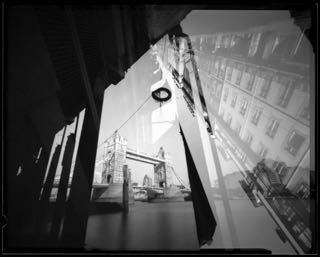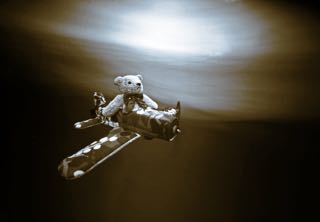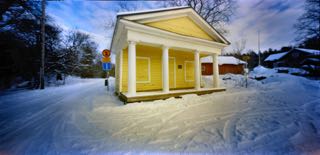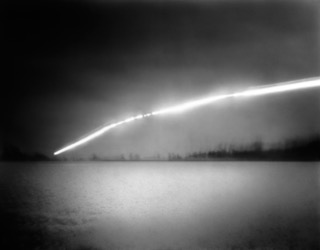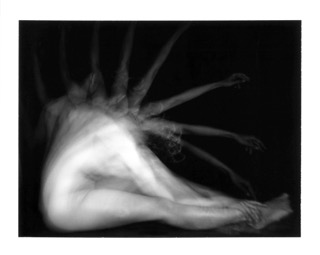In today’s digital photo rich world, pinhole photography is a bit of an obscure art form. Judging from reactions I get on the street, only about 1 in 5 folks know what pinhole photography is. Solargraphy is pinhole’s even lesser known cousin. However, the results achieved through Solargraphy are no less stunning.
[singlepic id=501 w=150 float=right][/singlepic]Solargraphy is essentially taking a pinhole camera loaded with photo paper and exposing it for a long time. Really long time. A week is probably the minimum, but many are exposed for months. This duration provides an interesting abstraction between the image of the world in front of the camera and traces of the sun as its relative path is changed by our planet’s trip around the sun. Add to that the unique coloration that happens to black and white photo paper over such long exposures, and you have a very unique image.[spacer height=”20px”]
[singlepic id=503 w=200 float=left][/singlepic]Jeff McConnell has scaled solargraphs to a level that I’ve not seen before. His Hunterdon Solargraphs project is ambitious, to say the least. He deployed more than 500 cameras, most of which for a period of 3 months or more. He started their exposures on the Fall equinox in 2015 and continued them through at least the Winter solstice – many for longer.[spacer height=”20px”]
[singlepic id=508 w=150 float=right][/singlepic]The army of cameras were deployed around his native Hunterdon County in New Jersey, mounting them to trees, poles, and other permanent structures. All of them pointed South to make the most of the sun’s journey. The result is a portrait of the place he lives, “but with an unfamiliar face.”[spacer height=”20px”]
Below are a sampling of Jeff’s comprehensive Hunterdon Solargraphy project for you to enjoy. After taking these in, I invite you to head over to Jeff’s website where he covers more of his Hunterdon project as well as his other great pinhole work. In addition, I’m pleased to announce that Jeff’s work will be featured in the OFF Foto festival, which starts today. If you’re in Europe over the course of the next month, you can see his work along with other ƒ/D featured photographers Joanna Epstein, Jesús Joglar, Stefan Killen, and Viktor Senkov.[spacer height=”40px”]
[singlepic id=514 w=600]Spruce Run Reservoir, ©Jeff McConnell, 2016[/singlepic][spacer height=”20px”]
[singlepic id=513 w=600]South Branch Raritan River, ©Jeff McConnell, 2016[/singlepic][spacer height=”20px”]
[singlepic id=512 w=600]Round Valley Reservoir, ©Jeff McConnell, 2016[/singlepic][spacer height=”20px”]
[singlepic id=511 w=600]Readingsburg NJ, ©Jeff McConnell, 2016[/singlepic][spacer height=”20px”]
[singlepic id=510 w=600]Lebanon Station NJT, ©Jeff McConnell, 2016[/singlepic][spacer height=”20px”]
[singlepic id=509 w=600]Ken Lockwood Gorge, ©Jeff McConnell, 2016[/singlepic][spacer height=”20px”]
[singlepic id=500 w=600]Five and Dime Frenchtown, NJ, ©Jeff McConnell, 2016[/singlepic][spacer height=”20px”]
[singlepic id=499 w=600]Barn on Senator Stout, ©Jeff McConnell, 2016[/singlepic][spacer height=”20px”]
[singlepic id=498 w=600]99 Days of Sun in High Bridge, ©Jeff McConnell, 2016[/singlepic][spacer height=”20px”]
